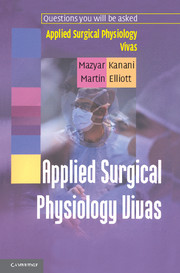Book contents
- Frontmatter
- Contents
- List of Abbreviations
- Dedication
- Preface
- A Change in Posture
- Acid-Base
- Action Potentials
- Adrenal Cortex I
- Adrenal Cortex II – Clinical Disorders
- Adrenal Medulla
- Arterial Pressure
- Autonomic Nervous System (ANS)
- Carbon Dioxide Transport
- Cardiac Cycle
- Cardiac Output (CO)
- Cell Signalling
- Cerebrospinal Fluid (CSF) and Cerebral Blood Flow
- Colon
- Control of Ventilation
- Coronary Circulation
- Fetal Circulation
- Glomerular Filtration and Renal Clearance
- Immobilization
- Liver
- Mechanics of Breathing I – Ventilation
- Mechanics of Breathing II – Respiratory Cycle
- Mechanics of Breathing III – Compliance and Elastance
- Mechanics of Breathing IV – Airway Resistance
- Microcirculation I
- Microcirculation II
- Micturition
- Motor Control
- Muscle I – Skeletal and Smooth Muscle
- Muscle II – Cardiac Muscle
- Nutrition: Basic Concepts
- Pancreas I – Endocrine Functions
- Pancreas II – Exocrine Functions
- Potassium Balance
- Proximal Tubule and Loop of Henle
- Pulmonary Blood Flow
- Renal Blood Flow (RBF)
- Respiratory Function Tests
- Small Intestine
- Sodium Balance
- Sodium and Water Balance
- Starvation
- Stomach I
- Stomach II – Applied Physiology
- Swallowing
- Synapses I – The Neuromuscular Junction (NMJ)
- Synapses II – Muscarinic Pharmacology
- Synapses III – Nicotinic Pharmacology
- Thyroid Gland
- Valsalva Manoeuvre
- Venous Pressure
- Ventilation/Perfusion Relationships
Mechanics of Breathing I – Ventilation
Published online by Cambridge University Press: 06 January 2010
- Frontmatter
- Contents
- List of Abbreviations
- Dedication
- Preface
- A Change in Posture
- Acid-Base
- Action Potentials
- Adrenal Cortex I
- Adrenal Cortex II – Clinical Disorders
- Adrenal Medulla
- Arterial Pressure
- Autonomic Nervous System (ANS)
- Carbon Dioxide Transport
- Cardiac Cycle
- Cardiac Output (CO)
- Cell Signalling
- Cerebrospinal Fluid (CSF) and Cerebral Blood Flow
- Colon
- Control of Ventilation
- Coronary Circulation
- Fetal Circulation
- Glomerular Filtration and Renal Clearance
- Immobilization
- Liver
- Mechanics of Breathing I – Ventilation
- Mechanics of Breathing II – Respiratory Cycle
- Mechanics of Breathing III – Compliance and Elastance
- Mechanics of Breathing IV – Airway Resistance
- Microcirculation I
- Microcirculation II
- Micturition
- Motor Control
- Muscle I – Skeletal and Smooth Muscle
- Muscle II – Cardiac Muscle
- Nutrition: Basic Concepts
- Pancreas I – Endocrine Functions
- Pancreas II – Exocrine Functions
- Potassium Balance
- Proximal Tubule and Loop of Henle
- Pulmonary Blood Flow
- Renal Blood Flow (RBF)
- Respiratory Function Tests
- Small Intestine
- Sodium Balance
- Sodium and Water Balance
- Starvation
- Stomach I
- Stomach II – Applied Physiology
- Swallowing
- Synapses I – The Neuromuscular Junction (NMJ)
- Synapses II – Muscarinic Pharmacology
- Synapses III – Nicotinic Pharmacology
- Thyroid Gland
- Valsalva Manoeuvre
- Venous Pressure
- Ventilation/Perfusion Relationships
Summary
1. What is the FiO2 of atmospheric air?
0.21, since 21% of the atmosphere is made up of oxygen.
2. What is the difference between minute ventilation and alveolar ventilation?
Minute ventilation is the total volume of air entering the respiratory tree every minute, and is equal to Tidal Volume (TV) × Respiratory Rate
Alveolar ventilation is the volume of gas entering the alveoli each minute. It takes into account the anatomic dead space. This volume of inspired air does not come into contact with respiratory epithelium. Alveolar ventilation is equal to (TV − Anatomic dead space) × Respiratory rate. In a resting 70 kg adult it is about (0.5 – 0.15) × 12 = 4.2Lmin−1
Thus, the alveolar ventilation is a more accurate measure of the level of ventilation since it takes into account only the volume of gas that interfaces with the respiratory epithelium. It can be seen that if a subject takes rapid, shallow breaths, they will become hypoxaemic despite numerically adequate minute ventilation.
3. What is meant by the oxygen cascade?
This term describes the incremental drops in the pO2 from the atmosphere to the arterial blood.
4. What are the changes in the oxygen cascade?
Atmospheric air: PO2 = 21 kPa
Tracheal air: pO2 = 19.8 kPa
Alveolar gas: pO2 = 14.0 kPa
Arterial blood gas: pO2 = 13.3 kPa
5. What about the changes in the partial pressure of CO2 along the respiratory tree?
Atmospheric air: PCO2 = 0.03 kPa
Alveolar air: PCO2 = 5.3 kPa
Arterial gas: PCO2 = 5.3 kPa
[…]
- Type
- Chapter
- Information
- Applied Surgical Physiology Vivas , pp. 71 - 72Publisher: Cambridge University PressPrint publication year: 2004



